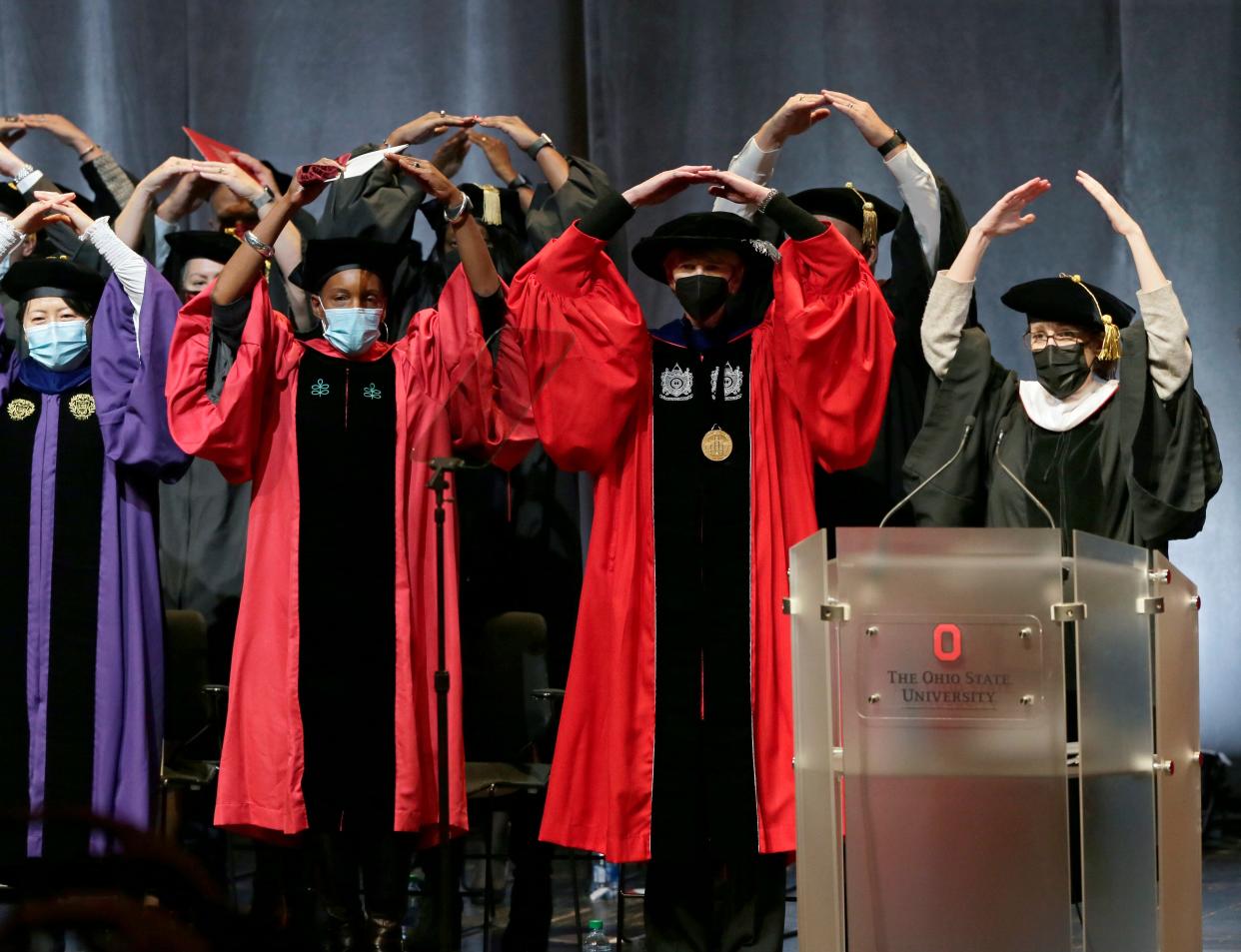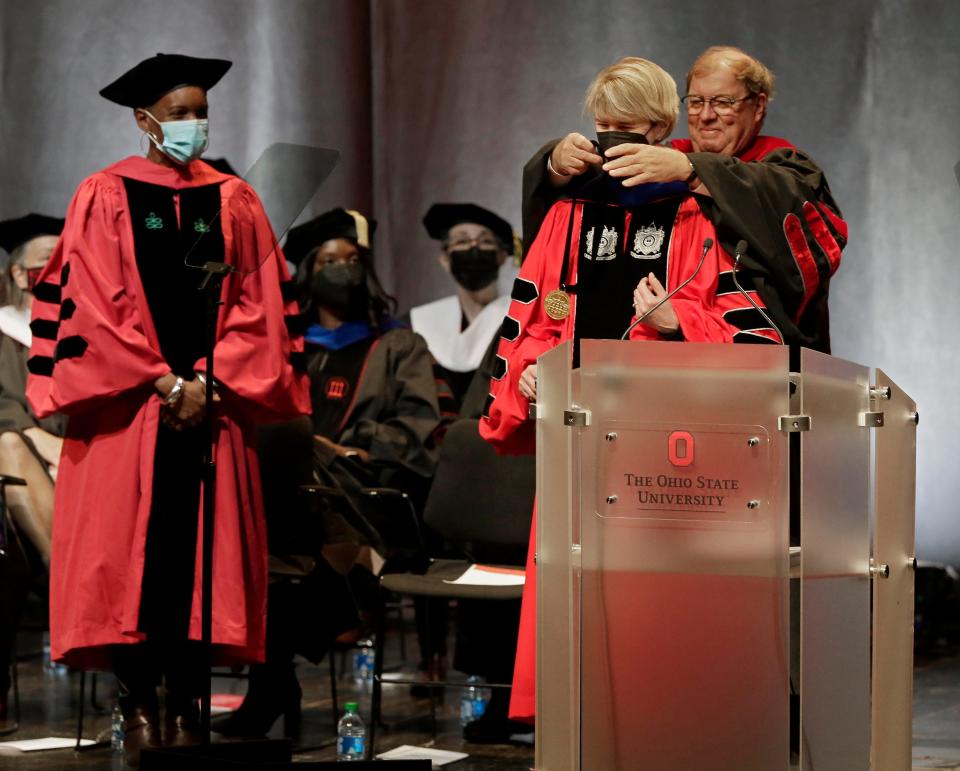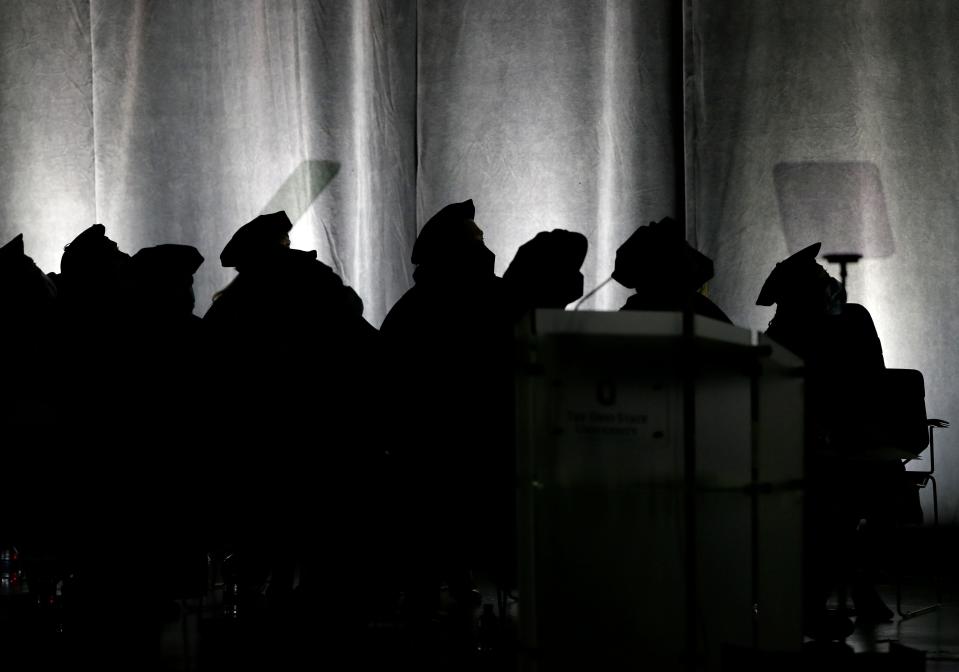Ohio State President Johnson lays out plan for debt-free bachelor's degree at investiture

- Oops!Something went wrong.Please try again later.
When Ohio State welcomes a new president to the helm, that individual is typically welcomed and formally assumes their role at an investiture ceremony.
Almost nothing in Kristina M. Johnson's presidency at Ohio State has been typical though thus far. She was hired as president in June 2020 amid a global health crisis, nationwide racial reckoning and questions about what an in-person school year would look like and whether the Buckeyes would take to the field that fall.
But Friday, more than a full year into her tenure because of the COVID-19 pandemic, Johnson took the oath of office and ceremoniously became Ohio State's 16th president. Her investiture took place at Mershon Auditorium before elected officials, university trustees, faculty and staff, students, community members and college representatives from across the country.

Ohio State news: Vaccine deadline passes at Ohio State, Ohio University. How many got the shot?
Dressed in ceremonial garb, Johnson reflected on her first year as president and looked to the future as she laid out her strategic goals.
A benefit of having her investiture well into her presidency is that Johnson was able to share some of her accomplishments up to this point. She touted the university's task force on community safety and well-being, and the public-private STEAMM Rising Initiative that will help better prepare Columbus City Schools students for careers.
She also outlined details of her plan to make Ohio State a debt-free institution, to double university research, hire more diverse tenure-track faculty members and make OSU more sustainable in the next decade.
"At my first State of the University speech last February, I said that I wanted to see Ohio State become the absolute model of a 21st century land-grant university," Johnson said. "That means recommitting to our land-grant mission ... we truly are a university of the people, by the people, for the people."
Johnson said she believes that a university education is "still the single-best way for young people from all backgrounds to engineer their own rise."
In the decade before the COVID-19 pandemic, the U.S. has seen an increase of more than 18 million net new jobs, and 89% of them went to people with at least a bachelor's degree.
But instead of higher education being a great equalizer, many institutions "seem to be concentrating privilege," she said.
One way that students, especially those who are low-income, can afford college is by borrowing money. About half of Ohio State students graduate with debt, with the average owing $27,000.
While loans can make college degrees a reality for many students who couldn't otherwise afford it, Johnson said debt can force students to make "life-narrowing choices." They may choose to pursue safer career paths instead of something they are passionate about. Or they might not go to graduate school, buy a home or start a family because of their loans.
"I want all of our graduates to be free to say yes to every great opportunity that comes their way," Johnson said.

What is the Scarlet and Gray Advantage?
With that goal in mind, Johnson introduced the Scarlet and Gray Advantage, the university's new plan to offer debt-free bachelor's degrees to undergraduates.
The program is designed so that participating students will be able to cover the cost of attendance through a combination of federal, state and university aid, work opportunities and family contribution.
Johnson was clear that the Scarlet and Gray Advantage is "not free college," reduced tuition or debt forgiveness. One of the major sticking points for stakeholders, Johnson told The Dispatch, is that students "would have some skin in the game."
Students must join Scarlet and Gray Advantage to take part in the program. Ohio State will provide scholarships and grants, coupled with paid work opportunities and internships. The university will also offer financial literacy courses and career counseling.
In turn, participating students will commit to graduating within four years, participate in financial literacy programs, take advantage of work opportunities, join a group of students also enrolled in the program, and fill out FAFSA, short for Free Application for Federal Student Aid, annually.
How will it be funded?
The Scarlet and Gray Advantage will be funded from four different sources. About half of the money will come from university donors, including alumni and corporate partners. The goal is to raise $800 million over the next decade to fund scholarships. Ohio State also announced it will match up to $50 million in private donations that support endowments for scholarships.
Funding will additionally come from cutting operational costs at the university; state and federal grants like the Ohio College Opportunity Grant and Pell Grant.
It's no secret that the job market is not equitable for everyone, Johnson said. Per-capita income in Ohio's rural areas is lower than the state average, Black and Hispanic families have been economically disenfranchised for decades, and women still earn less than men in most occupations.
Johnson said she hopes programs like the Scarlet and Gray Advantage will help level the playing field.
Ohio State will begin a pilot of the program next fall with 125 low- and middle-income first-year students.
Instead of being a distraction, Johnson said the COVID-19 pandemic has been a motivator to see her goals accomplished.
"As a land-grant university, we have an obligation to address those obstacles and to open up new opportunities wherever we can," she said.
Sheridan Hendrix is a reporter at the Columbus Dispatch covering higher education. Reach her at shendrix@dispatch.com. Follow her on Twitter @sheridan120.
This article originally appeared on The Columbus Dispatch: Debt-free Ohio State? President Kristina Johnson explains plan at investiture

